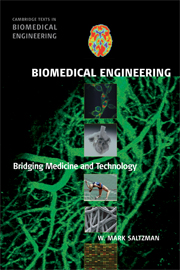Book contents
- Frontmatter
- Contents
- Preface
- Acknowledgments
- Abbreviations and Acronyms
- 1 Introduction: What Is Biomedical Engineering?
- PART 1 MOLECULAR AND CELLULAR PRINCIPLES
- PART 2 PHYSIOLOGICAL PRINCIPLES
- PART 3 BIOMEDICAL ENGINEERING
- 10 Biomechanics
- 11 Bioinstrumentation
- 12 Bioimaging
- 13 Biomolecular Engineering I: Biotechnology
- 14 Biomolecular Engineering II: Engineering of Immunity
- 15 Biomaterials and Artificial Organs
- 16 Biomedical Engineering and Cancer
- Appendix A Physiological Parameters
- Appendix B Chemical Parameters
- Appendix C Units and Conversion Factors
- Index
- Plate section
- References
10 - Biomechanics
from PART 3 - BIOMEDICAL ENGINEERING
- Frontmatter
- Contents
- Preface
- Acknowledgments
- Abbreviations and Acronyms
- 1 Introduction: What Is Biomedical Engineering?
- PART 1 MOLECULAR AND CELLULAR PRINCIPLES
- PART 2 PHYSIOLOGICAL PRINCIPLES
- PART 3 BIOMEDICAL ENGINEERING
- 10 Biomechanics
- 11 Bioinstrumentation
- 12 Bioimaging
- 13 Biomolecular Engineering I: Biotechnology
- 14 Biomolecular Engineering II: Engineering of Immunity
- 15 Biomaterials and Artificial Organs
- 16 Biomedical Engineering and Cancer
- Appendix A Physiological Parameters
- Appendix B Chemical Parameters
- Appendix C Units and Conversion Factors
- Index
- Plate section
- References
Summary
LEARNING OBJECTIVES
After reading this chapter, you should:
Understand the stress–strain curve and how properties of materials can be evaluated by examining their deformations under applied loads.
Understand the concept of elasticity in materials, and how it can be described by the Young's modulus.
Understand the importance of the relationship between structure, function, and material properties in human tissues.
Understand the intracellular structures that contribute to mechanical properties of cells.
Prelude
Humans can hold their bodies erect, vertically above the earth, because their bodies are solid objects capable of supporting their own weight. The human skeletal system is a collection of 206 bones, connected by soft tissues—cartilage, ligaments, tendons, and muscles—that together provide a mechanical support system for the human body.
Humans are also capable of movement. Muscles—connected to the solid bone framework—contract to generate forces that result in motion. Dancers, high jumpers, and surgeons learn to control these movements precisely to accomplish tasks and transport their bodies with precision (Figure 10.1). Strength, agility, and stamina can all be enhanced by training and, as a species, our understanding of the effects of training improves each year. As a result, humans continually improve performance on certain tasks, such as Olympic events (Figure 10.2).
This chapter describes some of the elements of human body structure and mechanics. To aid in description, the chapter begins with some basic concepts about the mechanical properties of materials.
- Type
- Chapter
- Information
- Biomedical EngineeringBridging Medicine and Technology, pp. 361 - 388Publisher: Cambridge University PressPrint publication year: 2009
References
- 1
- Cited by

